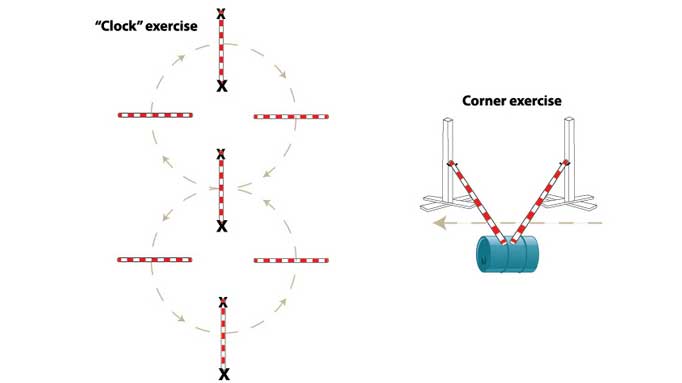Another challenge on course are corner jumps and arrowheads. Diana, who rides and coaches from her Donogue Farm in Blackstock, ON, talks about the strategy for riding turns and corners effectively.
“When it comes to turns, the biggest problem I see is people pulling on the inside rein and not turning from their outside aids. They are letting their horse’s shoulder pop out and it’s important to have the shoulders square. If the horse is popping out its shoulder, it’s easy for it to run out at a jump. Whether you are going to an arrow fence, a combination, or even a big galloping fence, you want your horse’s shoulders even so it jumps the fence squarely and doesn’t leave a leg behind. If you ride a turn by yanking on an inside rein, you can also pull your horse off balance – and balance, straightness, and rhythm are all things you want to keep flowing.
Here is an exercise you can set up to work on riding turns effectively, to practice keeping your horse’s shoulders square and riding from the outside aids. It also helps you develop an eye for distance. You’ll need three cavalettis and four poles, or you can use all poles. Set up a 20-metre circle, picturing the circle as a clock. Place the cavelettis at noon and 6:00 parallel to the long side of the arena and the trot poles at 9:00 and 3:00, parallel to the short sides. Repeat at the other end of the arena, using your 6:00 pole as the top of the second circle (see first diagram).
Warm up on the flat before you start; you want your horse moving off the leg. Start with the circle at the top of the arena. Canter around it, jumping over each pole or cavaletti. Keep your eyes up, looking around the circle, and use your outside rein and leg to keep the horse turning. You want to put in three even strides between each pole and cavaletti. If your horse’s shoulder is allowed to pop or you are pulling too much on the inside rein, you won’t be getting the right distance between poles.
When you are able to ride the circle smoothly with three strides between each pole, when you approach the pole in the middle of the arena, change your lead and ride the second circle on the other rein. When you become really proficient, you’ll be able to ride one circle on the left rein, change rein over the middle pole and ride the second circle on the right rein, and vice versa.
Here’s an exercise for practicing corners or arrow jumps. Create a little oxer by laying a barrel on its side and resting a pole on either end (see second diagram). Put the other ends of the poles into the standards, which you’ll set three feet apart on the other side of the jump. Put ground lines on either side of the jump.
Jump the little oxer a time or two, then create a V by moving the poles closer together on top of the barrel and widening the standards. Try to jump perpendicular to the V. Look at the jump and imagine a line straight across, then bisect that line at a 90-degree angle. That’s the line you want to jump. You can increase the difficulty of this exercise by moving the standards farther apart or by putting the barrel upright to make the jump higher. You can also practice by jumping single verticals and oxers on an angle, jumping over diagonally rather than straight on. Put your glove on a fence and jump at an angle, seeing how accurately you can jump over the glove.”

